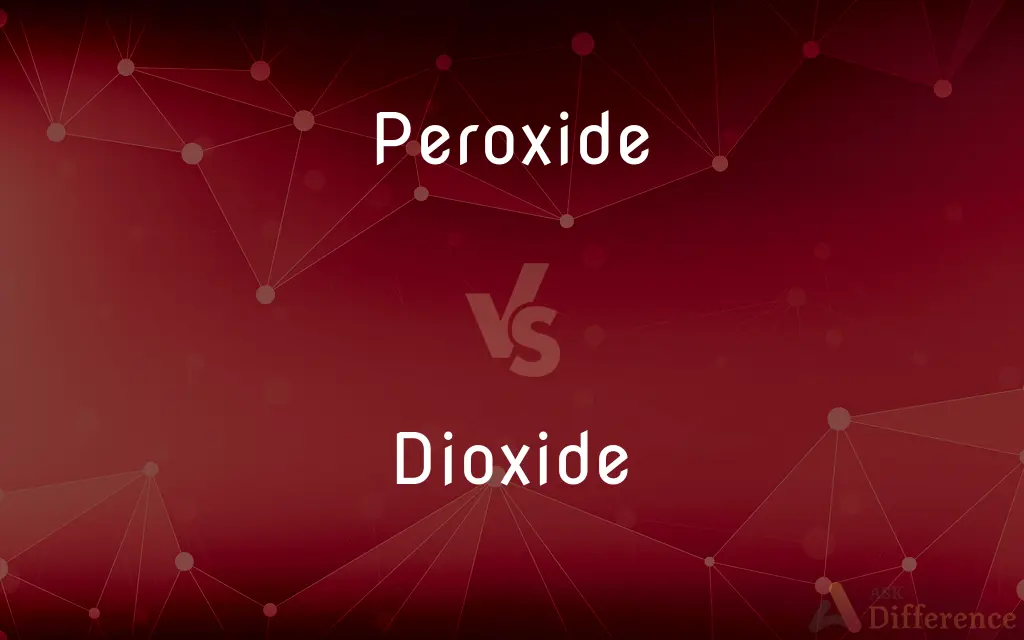Peroxide vs. Dioxide — What's the Difference?
Edited by Tayyaba Rehman — By Maham Liaqat — Updated on March 14, 2024
Peroxide involves an oxygen-oxygen bond, while dioxide contains two oxygen atoms bonded to another element.

Difference Between Peroxide and Dioxide
Table of Contents
ADVERTISEMENT
Key Differences
eroxides are chemical compounds that contain an oxygen-oxygen single bond (-O-O-), with the general formula R−O−O−R ′, where R and R ′ can be the same or different and can represent hydrogen, alkyl, or aryl groups. This bond is less stable than the typical oxygen bonds found in dioxides, making peroxides more reactive and often used as bleaching agents, disinfectants, and in some cases, as initiators in polymerization reactions. Dioxides, on the other hand, are compounds in which two oxygen atoms are bonded to another element, typically a metal or nonmetal, with the general formula XO2. Carbon dioxide (CO2) is the most well-known example, a colorless gas that is a byproduct of combustion and respiration, and a crucial greenhouse gas in Earth's atmosphere.
The key difference between peroxides and dioxides lies in the bonding and arrangement of oxygen atoms. In peroxides, the oxygen atoms are bonded to each other, which is a specific and notable characteristic that imparts certain reactive properties to these compounds. In dioxides, the oxygen atoms are not bonded to each other but are instead each bonded to another central atom, making dioxides generally more stable than peroxides.
Peroxides are known for their ability to release oxygen, a property that is exploited in applications that require oxidation or bleaching. Dioxides, however, do not readily release oxygen; their significance lies more in their structural and physical properties, such as in the case of carbon dioxide, which is vital for plant photosynthesis, or silicon dioxide, used in numerous technological applications.
The reactivity and applications of peroxides and dioxides differ markedly due to their structural differences. Peroxides' reactivity is harnessed in chemical syntheses and bleaching processes, whereas dioxides are valued for their stability and role in various geological, biological, and industrial processes.
Comparison Chart
Bonding
Contains an oxygen-oxygen single bond
Contains two oxygen atoms bonded to another element
ADVERTISEMENT
Stability
Generally less stable due to the -O-O- bond
Generally more stable, oxygen atoms bonded to a central atom
Examples
Hydrogen peroxide (H2O2), Benzoyl peroxide
Carbon dioxide (CO2), Silicon dioxide (SiO2)
Uses
Bleaching agents, disinfectants, polymerization initiators
Greenhouse gas, photosynthesis, glassmaking, semiconductors
Reactivity
Known for releasing oxygen, used in oxidation and bleaching
Does not readily release oxygen, valued for structural properties
Compare with Definitions
Peroxide
Compounds with an -O-O- bond.
Hydrogen peroxide is often used as a disinfectant and a bleaching agent.
Dioxide
Compounds with two oxygen atoms bonded to another element.
Carbon dioxide is a key component of Earth's atmosphere.
Peroxide
Reactive and used for bleaching.
Benzoyl peroxide is used in acne treatments for its ability to kill bacteria and bleach skin.
Dioxide
Used in industrial applications.
Titanium dioxide is widely used as a pigment and in sunscreen for its UV-blocking properties.
Peroxide
Can serve as initiators in polymerization.
Peroxide compounds are utilized to initiate the polymerization of plastics.
Dioxide
Generally more stable than peroxides.
Carbon dioxide is stable at room temperature and is a byproduct of combustion and respiration.
Peroxide
Can decompose to release oxygen.
Decomposition of peroxide is exploited in some chemical reactions to provide oxygen.
Dioxide
Do not readily release oxygen.
Despite containing oxygen, dioxides like CO2 do not easily release oxygen for other reactions.
Peroxide
Found in various concentrations for different applications.
The concentration of peroxide in hair bleaches is higher than in household disinfectants.
Dioxide
Involved in geological and biological processes.
Silicon dioxide forms the structural basis of quartz and is abundant in the earth's crust.
Peroxide
Peroxides are a group of compounds with the structure R−O−O−R, where R = any element. The O−O group in a peroxide is called the peroxide group or peroxo group.
Dioxide
A compound with two oxygen atoms per molecule.
Peroxide
The divalent O2 group, or a compound containing this group, such as sodium peroxide, Na2O2, used as an oxidizing agent or bleach.
Dioxide
(chemistry) Any oxide containing two oxygen atoms in each molecule.
Peroxide
Hydrogen peroxide.
Dioxide
An oxide containing two atoms of oxygen in each molecule; binoxide.
Peroxide
To treat with peroxide.
Dioxide
An oxide containing two atoms of oxygen in the molecule
Peroxide
To bleach (hair) with hydrogen peroxide.
Peroxide
(inorganic chemistry) A divalent radical or anion containing two oxygen atoms linked by a covalent bond; any substance containing this group which yields hydrogen peroxide when treated with an acid.
Peroxide
Hydrogen peroxide, especially when in an aqueous solution used as a bleach.
Peroxide
(organic chemistry) Any compound containing the functional group R-O-O-R'.
Peroxide
(transitive) To treat (something) with hydrogen peroxide, especially hair in order to bleach it.
Peroxide
An oxide containing more oxygen than some other oxide of the same element. Formerly peroxides were regarded as the highest oxides. Cf. Per-, 2.
Peroxide
A viscous liquid with strong oxidizing properties; a powerful bleaching agent; also used as a disinfectant and (in strong concentrations) as an oxidant in rocket fuels
Peroxide
An inorganic compound containing the divalent ion -O-O-
Peroxide
Bleach with peroxide;
She must peroxide her hair-it looks unnaturally blond
Common Curiosities
Can peroxides be dangerous?
Due to their reactivity, peroxides can be hazardous, particularly in concentrated forms, as they may cause burns, explosions, or act as strong oxidizers.
What makes peroxides reactive?
The oxygen-oxygen single bond in peroxides is less stable and more reactive than the oxygen bonds in dioxides, making peroxides prone to decomposition and useful as oxidizing agents.
Why are dioxides important in nature?
Dioxides, like carbon dioxide and silicon dioxide, play crucial roles in biological and geological processes, such as photosynthesis and the formation of Earth's crust.
Can peroxides be used as fuel?
Certain peroxides release a significant amount of oxygen upon decomposition, which can be harnessed in rocket propellants and other applications requiring a rapid release of oxygen.
How are dioxides used in technology?
Dioxides like silicon dioxide are fundamental in the production of glass, semiconductors, and as insulating materials in electronic devices.
Are all peroxides bleaching agents?
Many peroxides are used as bleaching agents due to their ability to release oxygen and break down color-causing compounds, but not all peroxides are used for this purpose.
How is silicon dioxide used in food?
Silicon dioxide is used as an anti-caking agent in powdered foods, preventing clumping by absorbing excess moisture.
What role do dioxides play in the carbon cycle?
Carbon dioxide is integral to the carbon cycle, being absorbed by plants for photosynthesis and released through respiration, decomposition, and combustion.
What is the environmental impact of dioxides?
Carbon dioxide, a common dioxide, is a significant greenhouse gas that contributes to global warming and climate change through the greenhouse effect.
How are peroxides stabilized for commercial use?
Peroxides are often stabilized with various additives to control their reactivity and prevent premature decomposition, especially in consumer products.
Share Your Discovery

Previous Comparison
Status vs. Prestige
Next Comparison
Shape vs. StructureAuthor Spotlight
Written by
Maham LiaqatEdited by
Tayyaba RehmanTayyaba Rehman is a distinguished writer, currently serving as a primary contributor to askdifference.com. As a researcher in semantics and etymology, Tayyaba's passion for the complexity of languages and their distinctions has found a perfect home on the platform. Tayyaba delves into the intricacies of language, distinguishing between commonly confused words and phrases, thereby providing clarity for readers worldwide.













































